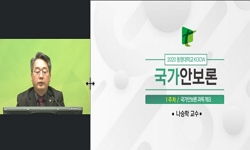The ancient Jeongchiwi local wine-drinking rite(正齒位 鄕飮酒禮), as described in the Three Ritual Classics, had a strong national characteristic. It was explained as one of the rituals that form the foundation for properly governing the countr...
http://chineseinput.net/에서 pinyin(병음)방식으로 중국어를 변환할 수 있습니다.
변환된 중국어를 복사하여 사용하시면 됩니다.
- 中文 을 입력하시려면 zhongwen을 입력하시고 space를누르시면됩니다.
- 北京 을 입력하시려면 beijing을 입력하시고 space를 누르시면 됩니다.

조선 후기 향음주례와 국가 역할에 대한 인식 = The perception of the role of the state on local wine-drinking rite in late Joseon
한글로보기https://www.riss.kr/link?id=A108578186
-
저자
박사랑 (-)
- 발행기관
- 학술지명
- 권호사항
-
발행연도
2023
-
작성언어
Korean
-
주제어
local wine-drinking rite(鄕飮酒禮) ; local rite ; Three Ritual Classics ; lee ik ; rule by rituals ; the government. ; 향음주례 ; 향례 ; 삼례 ; 이익 ; 국가 ; 예치
-
등재정보
KCI등재
-
자료형태
학술저널
- 발행기관 URL
-
수록면
105-140(36쪽)
- DOI식별코드
- 제공처
- 소장기관
-
0
상세조회 -
0
다운로드
부가정보
다국어 초록 (Multilingual Abstract)
Throughout the history of ceremonial institutions, the ancient characteristics of the Jeongchiwi local wine-drinking rite have either disappeared or been preserved. Among them, the aspect of the state attempting to operate the rite through the local officials within the bureaucratic system was maintained, which was also the case in the Joseon Dynasty. At the beginning of the dynasty, Joseon made a manual for the local wine-drinking rite as part of organizing national rites and named the local officials as both the organizers and key participants. These officials were also considered beings who would embody the will of the state. This trend continued in the late Joseon Dynasty, as evidenced by discussions in the central court and private letters among intellectuals.
It is crucial to understand the national context of the Jeongchiwi local wine-drinking rite, which previous scholarship has overlooked in favor of its local aspect.
The ancient Jeongchiwi local wine-drinking rite(正齒位 鄕飮酒禮), as described in the Three Ritual Classics, had a strong national characteristic. It was explained as one of the rituals that form the foundation for properly governing the country as a place to maintain the order between the older and the younger. When the Han and Tang dynasty commentators explained the Jeongchiwi local wine-drinking rite, they also recognized that the ritual was performed in the context of an ancient state’s political and social operation.
Throughout the history of ceremonial institutions, the ancient characteristics of the Jeongchiwi local wine-drinking rite have either disappeared or been preserved. Among them, the aspect of the state attempting to operate the rite through the local officials within the bureaucratic system was maintained, which was also the case in the Joseon Dynasty. At the beginning of the dynasty, Joseon made a manual for the local wine-drinking rite as part of organizing national rites and named the local officials as both the organizers and key participants. These officials were also considered beings who would embody the will of the state. This trend continued in the late Joseon Dynasty, as evidenced by discussions in the central court and private letters among intellectuals.
It is crucial to understand the national context of the Jeongchiwi local wine-drinking rite, which previous scholarship has overlooked in favor of its local aspect.
참고문헌 (Reference)
1 이태진, "한국사회사연구" 지식산업사 1986
2 이봉규, "풍석 서유구 연구 (하)" 사람의 무늬 2015
3 고영진, "조선 중기 향례에 대한 인식의 변화" 81 : 1998
4 김지영, "정조의 예치" 휴마니타스 2020
5 김문식, "1807년 경상감사 尹光顔의 鄕飮酒禮" 조선시대사학회 (87) : 193-222, 2018
6 김현수, "17世紀 鄕村敎化論과 鄕禮 認識 - 李惟泰, 尹鑴, 朴世采를 中心으로-" 동양고전학회 (39) : 187-208, 2010
7 김훈식, "15세기 후반기 향당윤리 보급의 배경" 99ㆍ100 : 1997
1 이태진, "한국사회사연구" 지식산업사 1986
2 이봉규, "풍석 서유구 연구 (하)" 사람의 무늬 2015
3 고영진, "조선 중기 향례에 대한 인식의 변화" 81 : 1998
4 김지영, "정조의 예치" 휴마니타스 2020
5 김문식, "1807년 경상감사 尹光顔의 鄕飮酒禮" 조선시대사학회 (87) : 193-222, 2018
6 김현수, "17世紀 鄕村敎化論과 鄕禮 認識 - 李惟泰, 尹鑴, 朴世采를 中心으로-" 동양고전학회 (39) : 187-208, 2010
7 김훈식, "15세기 후반기 향당윤리 보급의 배경" 99ㆍ100 : 1997
동일학술지(권/호) 다른 논문
-
- 서울대학교 규장각한국학연구원
- 양혜원
- 2023
- KCI등재
-
『高麗史』와 『高麗史節要』 卒記를 통해 본 고려시대 정치 지형
- 서울대학교 규장각한국학연구원
- 김원혁
- 2023
- KCI등재
-
- 서울대학교 규장각한국학연구원
- 이현진
- 2023
- KCI등재
-
- 서울대학교 규장각한국학연구원
- 홍해뜸
- 2023
- KCI등재




 KCI
KCI







